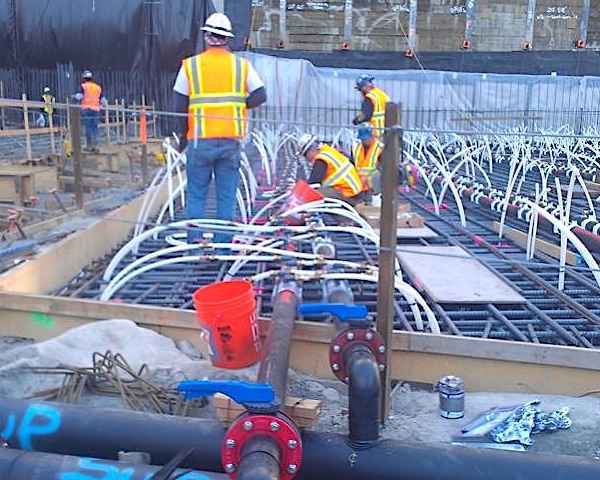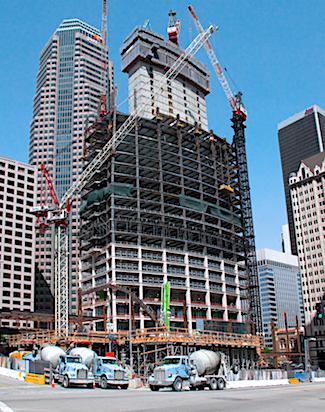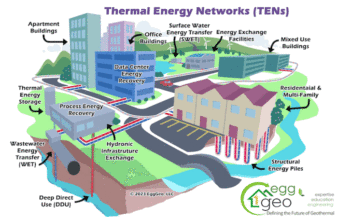 At 1,100 feet tall and 73 stories, the Wilshire Grand Center in Los Angeles, Calif., is the 10th tallest building in the United States and the tallest building west of the Mississippi. A structure of this magnitude requires precise engineering to ensure the building’s integrity while also incorporating creative and thoughtful design elements to meet the owners’ LEED® Gold certification requirements.
At 1,100 feet tall and 73 stories, the Wilshire Grand Center in Los Angeles, Calif., is the 10th tallest building in the United States and the tallest building west of the Mississippi. A structure of this magnitude requires precise engineering to ensure the building’s integrity while also incorporating creative and thoughtful design elements to meet the owners’ LEED® Gold certification requirements.
A team that included architect AC Martin, engineer of record Brandow and Johnston, Inc., structural engineer Thornton Tomasetti, and general contractor Turner Construction Company gathered to meet the lofty challenge.
The first decision was to deconstruct the original, 1951-built, 1.1-million-square-foot building instead of demolishing it. This allowed for many of the existing steel and concrete materials to be recycled instead of heading to the landfill.
The concrete was crushed into material that can be sold as Class II Base for structural fills, roads or building pads, while the steel beams were sent to a local foundry and melted down to make recycled reinforcing bars. This “green” deconstruction of the old building saved $4 million, making it not only good for the environment but also good for business.
After deconstruction, the focus turned to the design of the new, $1.2 billion structure. The base for the 2.1-million-square-foot building required a 21,200-cubic-yard concrete foundation located 84 feet below street level. To place that kind of concrete mass required a world-record continuous pour.

Completed in less than 19 hours, the 82 million pounds of concrete set a Guinness World Record for the largest continuous pour in a 24-hour period. And, to ensure structural integrity of the foundation’s massive slab, the design specified a hydronic radiant cooling system to draw off the heat as the concrete cured — a new trend that is becoming more popular for large concrete projects such as building foundations and bridges.
According to Mike Martin, piping department manager of Couts Heating and Cooling, Inc., the installing contractor for the thermal cooling radiant tubing installation, the idea of thermal cooling came about from an engineer in Minnesota who was looking to redirect the heat and keep an even temperature in the slab to prevent cracking after it cured.
 To ensure an effective thermal cooling system that would keep the slab at the proper temperature, the team at Couts installed more than 100,000 feet (20 miles) of ¾” PEX tubing from Uponor that intertwined through the rebar of the foundation. The tubing was used to convey 40-degree water throughout the system to maintain an even temperature that was not to exceed 160 degrees Fahrenheit as the concrete was poured and then cured.
To ensure an effective thermal cooling system that would keep the slab at the proper temperature, the team at Couts installed more than 100,000 feet (20 miles) of ¾” PEX tubing from Uponor that intertwined through the rebar of the foundation. The tubing was used to convey 40-degree water throughout the system to maintain an even temperature that was not to exceed 160 degrees Fahrenheit as the concrete was poured and then cured.
“The lighter weight of PEX made it easier to move around the jobsite and its extreme flexibility made it fast and easy to install around the rebar in the base of the structure,” said Martin. “Also, PEX is very forgiving. The installers were walking on it and dumping concrete on it, and it never damaged the pipe. Plus, any kinks in the pipe were easily repaired with a quick shot of heat from a heat gun, which is a big advantage for PEX-a type tubing. This eliminated the need to add in couplings in the slab.
Couts installed the radiant tubing at 6″ on center and dropped it down 18 feet from the 8″ HDPE supply header before looping it back up. Once the radiant tubing installation was complete, the concrete pour began. It was a steady, organized plan that required more than 400 workers, eight concrete plants, 208 mixers and more than 2,000 truckloads.
During the pour, the 40-degree water, sourced from a chiller system featuring a 40,000-gallon storage tank, began running through the system. The thermal cooling system pumped water throughout the tubing for two weeks while being continuously monitored by 24 sensors to ensure proper system temperatures. After the two-week timeframe, the water was removed from the system and the tubing was filled with grout and remained in the slab.
To date, the Wilshire Grand stands as a testament to new construction trends that promote business-smart sustainable design and even “green” deconstruction, an idea that will also be gaining traction as older buildings make way for new structures. And, according to Martin, concrete thermal cooling will also continue to increase as more and more professionals look to smarter building practices to make structures of higher performance.
In fact, just in his business alone, he notes that many general contractors are reaching out to his company to install thermal cooling systems for these types of applications. Since the Wilshire Grand, Couts has completed two bridges with concrete thermal cooling, and Martin estimates the trend will continue to grow.




Join the conversation: